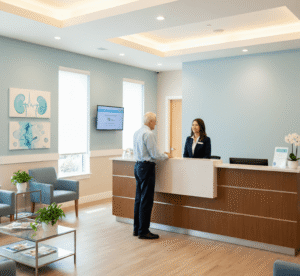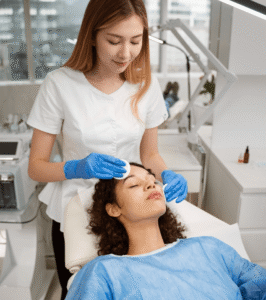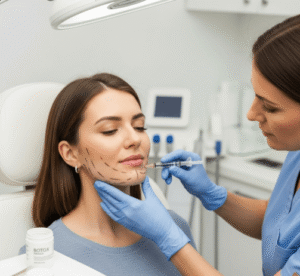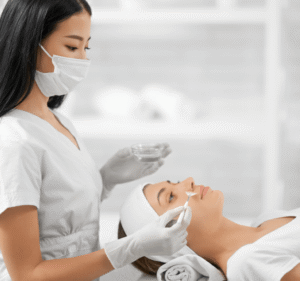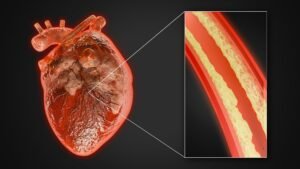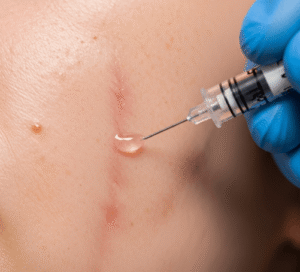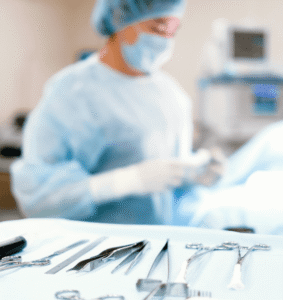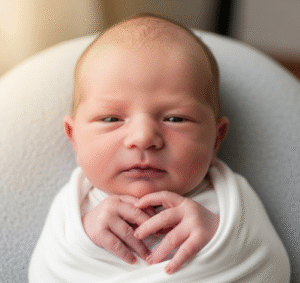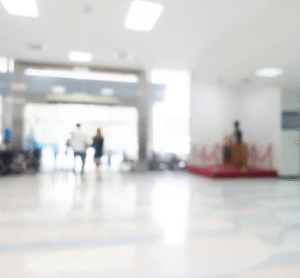What it is
Phymatous rosacea (PhR) in Korea is a severe form of rosacea characterized by thickened, bumpy skin, irregular surface texture, and enlargement of sebaceous glands.
It most commonly affects the nose (rhinophyma), but can also involve the forehead, chin, ears, or eyelids. The skin may appear coarse, bulbous, and reddish, often leading to significant cosmetic and psychological concerns.
→ Unlike other rosacea subtypes, PhR is progressive and does not resolve without medical or surgical treatment.
• In Korea, treatment plans combine laser therapy, surgical techniques, and supportive skincare to restore a smoother, more natural appearance.
• Because of Korea’s advanced dermatology and plastic surgery expertise, phymatous rosacea care often emphasizes both medical safety and aesthetic refinement.
Why it’s done
Patients in Korea seek treatment for phymatous rosacea due to:
→ Cosmetic appearance: Rhinophyma and thickened skin can distort facial features.
→ Psychological effects: Severe rosacea often leads to embarrassment, social anxiety, or low self-esteem.
→ Functional concerns: In extreme rhinophyma cases, thickened skin may obstruct breathing or vision.
→ Progression control: Without treatment, PhR tends to worsen and may become permanent.
→ Professional and social expectations in Korea: Clear, refined skin is a cultural standard, making treatment more desirable.
Alternatives
Besides medical and surgical treatments, some alternative or supportive approaches exist:
• Topical therapies → Metronidazole, azelaic acid, or ivermectin may control inflammation but do not reverse tissue thickening.
• Oral antibiotics → Doxycycline or isotretinoin may reduce inflammation but have limited effect on advanced phymatous changes.
• Camouflage makeup → May help reduce visible redness but cannot improve skin thickening.
→ Ultimately, procedural or surgical options are required for effective management of phymatous rosacea.
Preparation
Before undergoing phymatous rosacea treatment in Korea, preparation ensures safety:
- Dermatologist or plastic surgeon consultation → Determines severity and best approach.
- Skin assessment → Identifies vascular involvement, sebaceous gland enlargement, and degree of hypertrophy.
- Medical history review → Checks for contraindications to lasers, surgery, or isotretinoin.
- Pre-treatment skincare → Gentle cleansing, moisturizing, and SPF use to stabilize skin.
- Trigger avoidance → Alcohol, spicy foods, and hot beverages should be minimized to reduce flare-ups.
→ Korean clinics often start with anti-inflammatory treatment before surgical or laser procedures.
How it’s done
Phymatous rosacea management in Korea usually requires a combination of procedural methods:
- Laser therapy
- CO₂ fractional laser → Resurfaces thickened skin, smooths irregular texture, and shrinks sebaceous tissue.
- Er:YAG laser → Offers precise tissue removal with less thermal damage.
- Vascular lasers (V-beam) → Target associated redness and dilated vessels.
- Surgical techniques
- Electrosurgery or dermabrasion → Used to sculpt and smooth hypertrophic skin.
- Surgical excision → In extreme rhinophyma cases, thickened tissue may be removed.
- Shaving techniques → Carefully reduce excess tissue layer by layer.
- Medical therapy
- Isotretinoin (low dose) → Helps reduce sebaceous gland overgrowth.
- Topicals (metronidazole, azelaic acid) → Maintain control of underlying rosacea inflammation.
- Supportive care
- Post-procedure LED healing therapy, cooling masks, and regenerative serums to speed recovery.
→ Treatment is usually staged over several sessions, with surgery or ablative lasers reserved for advanced cases.
Recovery
Recovery after phymatous rosacea treatment in Korea varies depending on the method:
• Laser resurfacing → Redness, swelling, and crusting for 1–2 weeks; new smoother skin appears gradually.
• Surgical reduction → Longer healing time, with stitches or wound dressings required.
• Medical therapy → Minimal downtime, but results are gradual and maintenance-based.
• Aftercare focus → Moisturizers, sunscreens, and barrier-repair creams are emphasized.
→ Final results often show dramatic cosmetic improvement within weeks to months, with long-term skin stability.
Complication
While safe in expert hands, phymatous rosacea treatment can carry risks:
- Scarring → Possible if deep surgical or ablative methods are required.
- Pigmentation changes → Post-inflammatory hyperpigmentation or hypopigmentation may occur.
- Infection → Rare, but possible after surgical or laser procedures.
- Recurrence → PhR can return if underlying rosacea is not managed.
- Skin sensitivity → Some patients experience long-term sensitivity to sun or skincare products.
→ Korean clinics minimize risks by combining staged approaches with strict aftercare guidance.
Treatment option in Korea
Korea is a global leader in rosacea and scar management, making it a prime destination for phymatous rosacea care:
→ Advanced laser systems → Fractional CO₂, Er:YAG, and V-beam are widely used in Seoul and Busan clinics.
→ Plastic surgery expertise → For advanced rhinophyma, Korea offers skilled surgical interventions with an emphasis on aesthetics.
• Combination therapy → Many clinics combine laser resurfacing with medical therapy for better long-term results.
• Aesthetic philosophy → Korean treatments aim not just to remove tissue but to restore natural contours and smooth, refined skin.
• Medical tourism → International patients come to Korea for phymatous rosacea correction due to its advanced care and cosmetic precision.
→ With a focus on both function and beauty, Korea provides some of the most effective and aesthetically refined treatments for phymatous rosacea, helping patients regain confidence and facial harmony.


